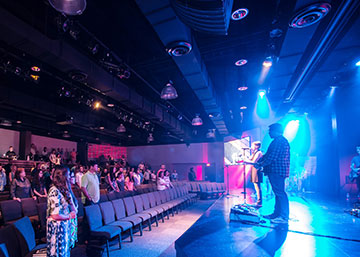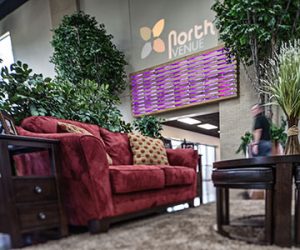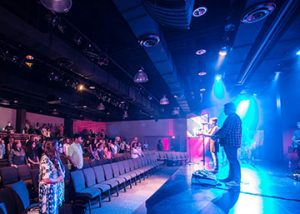
By RaeAnn Slaybaugh
Sometimes, renovation or expansion makes more sense than new construction.
Right now, construction and design experts will tell you that among their church clients, renovation or expansion of existing spaces is very common. Experts like Rodney C. James, business manager / director of finance at Daniels & Daniels Construction in Broken Arrow, OK, say there’s a good reason for this: “A church that has established an identity in the community often is hindered by relocating rather than changing who they are, where
they are.”
RELATED RESOURCES:
- How to divide and conquer (your space)
- When building expansion becomes stewardship
- Manage expansion uncertainty
To this end, Craig Krawczyk, architect/principal at LIVE Design Group in Birmingham, AL, says the majority of his firm’s projects have a renovation component, now. “It’s typical that a church builds a new worship facility adjacent an existing facility and repurposes that existing space.”
His colleague, Aubrey Garrison, AIA — founding principal of the firm — agrees. These days, he says, church clients often reimagine their outgrown space as a youth sanctuary and children’s space.

Know the signs
If you think it might be time to renovate or expand at your own church, it helps to know the signals.
Capacity cues. Church construction and design experts acknowledge an oft-cited expansion benchmark: when seating reaches 80-percent capacity. While Daniels & Daniels’ Rodney C. James generally agrees, he says a church should begin planning for expansion at 60- or 70-percent capacity if it’s growing at a healthy pace. “You don’t want to reach the 80- or 90-percent mark and begin a decline before taking action,” he warns.
On the other hand, he asserts that renovation (versus expansion) is the best option for churches that are growing, have adequate parking to accommodate that growth, and whose facilities are in good mechanical and structural co ndition. “In these cases, there’s often no need to incur the expense of new land, new infrastructure (utilities, site work and so on), and often zoning and permitting challenges,” he explains. “The best use of funds can be to renovate existing facilities.
ndition. “In these cases, there’s often no need to incur the expense of new land, new infrastructure (utilities, site work and so on), and often zoning and permitting challenges,” he explains. “The best use of funds can be to renovate existing facilities.
Another “green light” indicator for renovation is declining capacity, according to James. “If the church isn’t reaching the community, perhaps it’s because their facilities need a facelift — a repurposing, or possibly even a dramatic change.”

(Photos courtesy of LIVE Design Group)
Small groups growth. Many churches built decades ago have classrooms built to accommodate 10 to 15 people. Today, however, many small groups welcome between 20 and 50 people at once.
Scott M. Ladd, marketing manager at ModernFold in Greenfield, IN, witnesses this kind of space crunch all the time. “We find that church facilities look to make changes to their space maximization when things just aren’t working anymore — when they’ve started to outgrow what the space was originally designed for, or when new space demands arise,” he says.
At these junctures, operable partitions warrant consideration, on a retrofit basis. “We really like to get ahead of this need on new church construction projects,” Ladd emphasizes. This means consulting with the architect and interior designer during the design phase to determine how various spaces within the church will be used. Doing so enables Ladd and his team to advise on the proper partition product and layout — for now and for the future.
Shifting worship style. As more and more churches elect to offer contemporary worship services, many are finding that their sanctuaries don’t exactly scream “modern.”
Beyond the structure itself, this style of service necessitates A/V elements that a church might not have prioritized before: video projection, theatrical lighting, moving lights, environmental projection, updated sound systems, and expanding stages to accommodate new band instruments, to name just a few.
“Church has changed more in the last decade than it has in the last several decades,” Daniels & Daniels’ Rodney C. James explains. “The greatest shift has been in the worship facilities needing to accommodate the contemporary feel.”
Changing worshipper demographics. These days, a healthy faction of  church architecture and design experts assert that the ideal facility balances worship seating requirements with children’s space requirements. LIVE Design Group’s Aubrey Garrison is among them.
church architecture and design experts assert that the ideal facility balances worship seating requirements with children’s space requirements. LIVE Design Group’s Aubrey Garrison is among them.
“As a church grows, the demographics between these two can change and create an imbalance,” he shares. “Inadequacies in either worship seating or children’s space can limit a church’s growth.” Because each church and its facilities is unique, he recommends an informed space study to help guide future building or renovation decisions.
Craig Krawczyk agrees that when children’s education space is maxed out, it’s time to consider an expansion project. “Full children’s spaces indicate good growth — but it also starts turning parents away,” he warns. “For most churches, the size of children’s space drives the size of the rest of the facility.”

A new fellowship feel. Beyond worship areas, architects suggest that a new generation of worshippers is looking for “gathering spaces.” As Rodney C. James points out, this is a At Concord United Methodist Church in Knoxville, TN, acoustical partitions hide band equipment in a multi-use worship room.
Custom cut-outs ensure the space’s stained glass windows are always visible.group of individuals who meets up At Concord United Methodist Church in Knoxville, TN, acoustical partitions hide band equipment in a multi-use worship room. Custom cut-outs ensure the space’s stained glass windows are always visible.at Starbucks and gathers at the mall, socially.
“So, churches are stepping up and creating warm, welcoming places to hang out and experience fellowship before and between services,” he says. This trend has taken shape in the widespread addition of coffee shops, seating areas and informal gathering places in churches, all of which have led the way in renovations and space maximization efforts.
Is your space expansion- or renovation- ready?
Some facilities lend themselves to renovation or expansion better than others. So, what should you look for in your own spaces?
According to LIVE Design Group’s Craig Krawczyk, steel construction is the most economical and flexible construction method to modify. Meanwhile, structural masonry is much less economical and more difficult to modify, and pre-engineered metal buildings can be renovated on the interior, but provide challenges when connecting them to newly constructed additions.
Also, recent code changes make adding to existing facilities more difficult, as his colleague, Aubrey Garrison, points out. For example, an existing church might not have a sprinkler system, but a new worship space would likely require one. “Careful planning can add the new worship space in a way that provides fire separation between the new construction and the existing building,” he explains.
Even adding partitions comes with some architectural considerations. According to ModernFold’s Scott M. Ladd, overhead support is a key element, as partitions are hung using an overhead suspension system.
Even so, the company offers a truss system to carry the weight of the partition if overhead support is missing. The system can be finished to match the partitions and the surroundings. It is brought into the facility in small pieces and assembled onsite, so there’s no need for large equipment.
Not your grandfather’s expansion project
Aside from bricks-and-mortar expansion, churches are also thinking outside the box when it comes to making the most of the space they have — or renovating an existing space.
 St. Agnes Catholic Church in Concord, CA, features a full-height, custom mural made of glass partitions which divide the lobby and worship areas. Photo courtesy of ModernFold.According to Daniels & Daniels’ Rodney C. James, one major trend is using “other” types of facilities to accommodate church growth. “When a church is growing, often the first building project isn’t a new facility, but the renovation of an old grocery store, an abandoned big box store, or a lumber yard/warehouse building.”
St. Agnes Catholic Church in Concord, CA, features a full-height, custom mural made of glass partitions which divide the lobby and worship areas. Photo courtesy of ModernFold.According to Daniels & Daniels’ Rodney C. James, one major trend is using “other” types of facilities to accommodate church growth. “When a church is growing, often the first building project isn’t a new facility, but the renovation of an old grocery store, an abandoned big box store, or a lumber yard/warehouse building.”
In other facilities, divvying up existing space more creatively has proven to be the best expansion option. ModernFold’s Scott M. Ladd cites the example of St. Agnes Catholic Church in Concord, CA, which used glass partitions to divide a lobby area from a worship area.
“The unique feature of this application is the full-height custom mural that was etched into the glass of each panel,” he says. “So, these partitions not only divide space effectively, they truly tell a story.” Another unique application — this one at Concord United Methodist Church in Knoxville, TN — uses acoustical partitions to hide band equipment in their multi-use worship room. Uniquely, these panels feature large, custom window cut-outs so the stained glass windows are always visible in the background while the partitions are closed.


